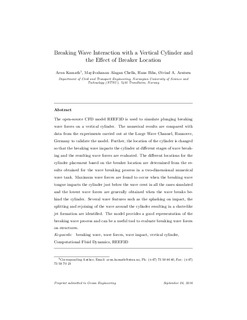| dc.contributor.author | Kamath, Arun | |
| dc.contributor.author | Alagan Chella, Mayilvahanan | |
| dc.contributor.author | Bihs, Hans | |
| dc.contributor.author | Arntsen, Øivind Asgeir | |
| dc.date.accessioned | 2016-10-17T08:45:56Z | |
| dc.date.accessioned | 2016-10-31T09:04:40Z | |
| dc.date.available | 2016-10-17T08:45:56Z | |
| dc.date.available | 2016-10-31T09:04:40Z | |
| dc.date.issued | 2016 | |
| dc.identifier.citation | Ocean Engineering 2016 | nb_NO |
| dc.identifier.issn | 0029-8018 | |
| dc.identifier.uri | http://hdl.handle.net/11250/2418237 | |
| dc.description.abstract | The open-source CFD model REEF3D is used to simulate plunging breaking wave forces on a vertical cylinder. The numerical results are compared with data from the experiments carried out at the Large Wave Channel, Hannover, Germany to validate the model. Further, the location of the cylinder is changed so that the breaking wave impacts the cylinder at different stages of wave breaking and the resulting wave forces are evaluated. The different locations for the cylinder placement based on the breaker location are determined from the results obtained for the wave breaking process in a two-dimensional numerical wave tank. Maximum wave forces are found to occur when the breaking wave tongue impacts the cylinder just below the wave crest in all the cases simulated and the lowest wave forces are generally obtained when the wave breaks behind the cylinder. Several wave features such as the splashing on impact, the splitting and rejoining of the wave around the cylinder resulting in a chute-like jet formation are identified. The model provides a good representation of the breaking wave process and can be a useful tool to evaluate breaking wave forces on structures. | nb_NO |
| dc.language.iso | eng | nb_NO |
| dc.publisher | Elsevier | nb_NO |
| dc.relation.uri | http://dx.doi.org/10.1016/j.oceaneng.2016.10.025 | |
| dc.rights | Navngivelse-Ikkekommersiell-IngenBearbeidelse 3.0 Norge | * |
| dc.rights.uri | http://creativecommons.org/licenses/by-nc-nd/3.0/no/ | * |
| dc.title | Breaking Wave Interaction with a Vertical Cylinder and the Effect of Breaker Location | nb_NO |
| dc.type | Journal article | nb_NO |
| dc.type | Peer reviewed | nb_NO |
| dc.date.updated | 2016-10-17T08:45:56Z | |
| dc.source.pagenumber | 105-115 | nb_NO |
| dc.source.volume | 128 | nb_NO |
| dc.source.journal | Ocean Engineering | nb_NO |
| dc.identifier.doi | 10.1016/j.oceaneng.2016.10.025 | |
| dc.identifier.cristin | 1391401 | |
| dc.description.localcode | © 2016 Elsevier Ltd. All rights reserved. This is the authors' accepted and refereed manuscript to the article. Locked until 2018-12-01. Author's post-print is released with a Creative Commons Attribution Non-Commercial No Derivatives License. | nb_NO |

